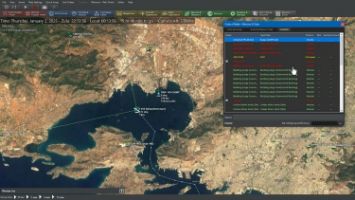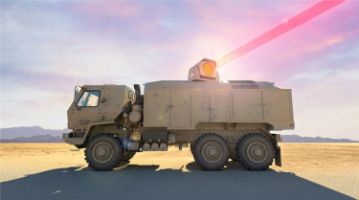Strategic Technology Office Outlines Vision for “Mosaic Warfare”

STO seeks to turn complexity into a powerful new asymmetric weapon via rapidly composable networks of low-cost sensors, multi-domain command and control nodes, and cooperative manned and unmanned systems
DARPA’s Strategic Technology Office (STO) this week unveiled its updated approach to winning or deterring future conflicts during Sync with STO Day, held in Arlington, Virginia. At the event—which attracted about 300 innovators and entrepreneurs, more than half of whom had never worked with DARPA before—STO program managers outlined new areas of interest and held discussions with attendees to explore innovative technology solutions for strategic national security challenges.
The foundation of STO’s new strategy rests on the recognition that traditional U.S. asymmetric technology advantage—such as highly advanced satellites, stealth aircraft, or precision munitions—today offer a reduced strategic value because of growing global access to comparable high-tech systems and components, many of which are now commercially available. Additionally, the high cost and sometimes decades-long development timelines for new military systems can’t compete with the fast refresh rate of electronics component technology on the commercial market, which can make new military systems obsolete before they’re delivered.
STO’s updated strategy seeks a new asymmetric advantage—one that imposes complexity on adversaries by harnessing the power of dynamic, coordinated, and highly autonomous composable systems.
“We’ve developed a technology-based vision that would enable highly complex, strategic moves by composing multiple contributing systems to enable what might be thought of as ‘mosaic warfare,’ in which individual components can respond to needs in real time to create desired outcomes,” said Tom Burns, director of STO. “The goal is to fight as a network to create a chain of effects—or, more accurately because these effects are not linear, ‘effects webs’—to deter and defeat adversaries across multiple scales of conflict intensity. This could be anything from conventional force-on-force battles to more nebulous ‘Gray Zone’ conflicts, which don’t reach the threshold of traditional military engagements but can be equally disruptive and subversive.”
U.S. military power has traditionally relied upon monolithic military systems where one type of aircraft, for example, is designed to provide a single end-to-end capability tailored to a very specific warfighting context—and be a significant loss if shot down. In contrast, the composable effects webs concept seeks a mosaic-like flexibility in designing effects for any threat scenario. By using less expensive systems brought together on demand as the conflict unfolds, these effects webs would enable diverse, agile applications—from a kinetic engagement in a remote desert setting, to multiple small strike teams operating in a bustling megacity, or an information operation to counter an adversary spreading false information in a population threatening friendly forces and strategic objectives. Mosiacs can rapidly be tailored to accommodate available resources, adapt to dynamic threats, and be resilient to losses and attrition.
“When building a mosaic, the key is the simple and versatile building blocks that artists have at their disposal from which to make complex designs,” said Dan Patt, deputy director of STO. “Applying the great flexibility of the mosaic concept to warfare, lower-cost, less complex systems may be linked together in a vast number of ways to create desired, interwoven effects tailored to any scenario. The individual parts of a mosaic are attritable, but together are invaluable for how they contribute to the whole. This means that even if an adversary can neutralize a number of pieces of the mosaic, the collective can instantly respond as needed to still achieve the desired, overall effect.”
The mosaic warfare concept is more highly evolved than previous approaches that envisioned a monolithic “system of systems.” These were intractably complex, designed as a static configuration by a single system integrator. Attempts to make these systems of systems more flexible sought to accommodate a more diverse selection of constituent components by enforcing a particular architecture. Such constructs typically require adherence to a particular standard, or sometimes used a proprietary “universal translator” to make a limited family of systems work together. “While an open standard may offer interoperability for a period of time, developing them is time-consuming, expensive, and requires compromise. And inevitably, as soon as a standard is agreed upon, someone comes up with a new idea not considered during the standards-development process and is either locked out or the whole process must start over again. Ultimately, this approach just does not scale well,” Patt said.
“The mosaic warfighting concept moves beyond any one organization, military Service, or company’s system designs and the requisite interoperability standards, which are inherently inhibiting and unscalable,” Patt said. “We’re focused on developing processes and tools that would focus on trusted connections between known entities, enabling easy backwards compatibility and just-in-time, custom creation of any needed connections to enable rapid, intelligent, strategic assembly and disassembly of diverse systems. This construct opens a virtually limitless possibility for creating effects webs at the tactical, operational, and campaign levels.”
STO’s strategy stands to enhance the effectiveness of existing military capabilities across all domains – maritime, ground, air, space, and cyberspace, as well as enable new, low-cost unmanned systems that the Services, DARPA, and companies anticipate building in the future. The mosaic strategy is also anticipated to change the way the military thinks about designing and buying future systems. Instead of spending years or even decades building exquisite, monolithic systems to rigid requirements, future acquisition programs would be able to buy mosaic “tiles” at a rapid, continuous pace. The true power of the new capabilities will come from the composite mosaic effects.
The approach will draw in part on a number of existing DARPA programs that are developing enabling technologies to achieve the challenging mosaic warfare architecture, including: The Complex Adaptive System Composition And Design Environment (CASCADE) program is addressing composition of existing and new systems; the System of Systems Integration Technology and Experimentation (SoSITE) program is focused on integrating the various systems to work together; Distributed Battle Management (DBM) and Resilient Synchronized Planning and Assessment for the Contested Environment (RSPACE) are addressing battle management command and control; and Communications in Contested Environments (C2E) and Dynamic Network Adaptation for Mission Optimization (DyNAMO) are focused on seamless, adaptable communications and networking.
To further the new vision, STO has identified specific areas of interest for proposals to achieve next-generation composable effects webs: Situation Understanding, Multi-Domain Maneuver, Hybrid Effects, System of Systems (SoS), Maritime Systems, System of System-Enhanced Small Units (SESU), and Foundational Strategic Technologies and Systems. A description of each area and proposal submission guidelines are available in the STO office-wide BAA on FedBizOpps, viewable here: HR001117S0015.
STO is interested in hearing from companies, institutions, and technologists with expertise in the above areas, particularly those that have not worked with STO before who may bring fresh perspectives.
“If we’re successful,” Burns said, “mosaic warfighting and resulting effects webs will give us the ability to inflict vast levels of complexity on an adversary to deter and counter aggression.”
Image Caption: DARPA's Strategic Technology Office seeks to turn complexity into a powerful new asymmetric weapon via rapidly composable networks of low-cost sensors, multi-domain command and control nodes, and cooperative manned and unmanned systems. Using the concept of a mosaic, which comprises many smaller individual pieces, STO is applying "mosaic warfare" to link together lower-cost, less complex systems in a vast number of ways to create desired, interwoven effects tailored to any scenario.






